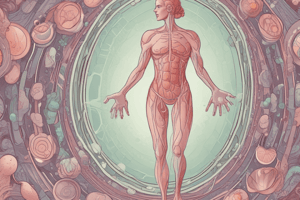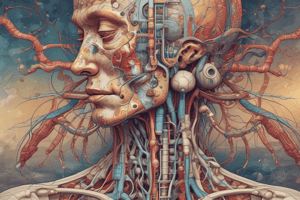Podcast
Questions and Answers
What is the main function of the tropic hormones of the anterior pituitary?
What is the main function of the tropic hormones of the anterior pituitary?
- To regulate the secretion of growth hormone
- To directly regulate physiological processes
- To inhibit the production of hormones by the posterior pituitary
- To stimulate the production of other hormones (correct)
What is the role of the hypothalamic-hypophysial portal system?
What is the role of the hypothalamic-hypophysial portal system?
- To stimulate the production of hormones by the posterior pituitary
- To inhibit the production of hormones by the anterior pituitary
- To transport hormones from the hypothalamus to the anterior pituitary (correct)
- To regulate the secretion of growth hormone
What is the effect of insulin-like growth factor-1 (IGF-1) on growth hormone secretion?
What is the effect of insulin-like growth factor-1 (IGF-1) on growth hormone secretion?
- It has no effect on growth hormone secretion
- It increases growth hormone secretion
- It only affects growth hormone secretion in children
- It decreases growth hormone secretion (correct)
What is the physiological effect of antidiuretic hormone (ADH)?
What is the physiological effect of antidiuretic hormone (ADH)?
What is the main difference between the anterior and posterior pituitary glands?
What is the main difference between the anterior and posterior pituitary glands?
What is the primary function of the hormone produced by lactotropes in the anterior pituitary gland?
What is the primary function of the hormone produced by lactotropes in the anterior pituitary gland?
What is the name of the bony structure that the pituitary gland resides in?
What is the name of the bony structure that the pituitary gland resides in?
What is the term for the hormones produced by the anterior pituitary gland that stimulate other endocrine glands?
What is the term for the hormones produced by the anterior pituitary gland that stimulate other endocrine glands?
What is the name of the surgical procedure that removes pituitary tumors through the nose?
What is the name of the surgical procedure that removes pituitary tumors through the nose?
What is the primary role of the hypothalamus in the endocrine system?
What is the primary role of the hypothalamus in the endocrine system?
What type of hormones does the hypothalamic neurons synthesize?
What type of hormones does the hypothalamic neurons synthesize?
What is the function of the hypothalamic-hypophysial portal system?
What is the function of the hypothalamic-hypophysial portal system?
What is the effect of releasing hormones on the anterior pituitary?
What is the effect of releasing hormones on the anterior pituitary?
What is the function of the hypothalamic-pituitary axis?
What is the function of the hypothalamic-pituitary axis?
What is the role of the median eminence in the hypothalamic-pituitary axis?
What is the role of the median eminence in the hypothalamic-pituitary axis?
What is the difference between short-loop and long-loop feedback in the hypothalamic-pituitary axis?
What is the difference between short-loop and long-loop feedback in the hypothalamic-pituitary axis?
What is the hypothalamic-neurohypophyseal axis responsible for?
What is the hypothalamic-neurohypophyseal axis responsible for?
What is the function of growth hormone-inhibiting hormone (GHIH)?
What is the function of growth hormone-inhibiting hormone (GHIH)?
Which hormone is predominantly under negative control from the hypothalamus?
Which hormone is predominantly under negative control from the hypothalamus?
What is the primary function of Growth Hormone in early development?
What is the primary function of Growth Hormone in early development?
Which of the following is a characteristic of the somatotropic axis?
Which of the following is a characteristic of the somatotropic axis?
What is the primary function of Insulin-Like Growth Factor-1 (IGF-1)?
What is the primary function of Insulin-Like Growth Factor-1 (IGF-1)?
What is the result of excessive Growth Hormone secretion before the closure of epiphyses?
What is the result of excessive Growth Hormone secretion before the closure of epiphyses?
What is the effect of Growth Hormone on glucose metabolism?
What is the effect of Growth Hormone on glucose metabolism?
Which of the following is a factor that increases Growth Hormone secretion? (2)
Which of the following is a factor that increases Growth Hormone secretion? (2)
What is the result of Growth Hormone deficiency in childhood?
What is the result of Growth Hormone deficiency in childhood?
What is the primary function of Growth Hormone in adults?
What is the primary function of Growth Hormone in adults?
What is the effect of Insulin-Like Growth Factor-1 (IGF-1) on somatostatin neurons?
What is the effect of Insulin-Like Growth Factor-1 (IGF-1) on somatostatin neurons?
What is the primary function of antidiuretic hormone (ADH) in the body?
What is the primary function of antidiuretic hormone (ADH) in the body?
Where are the peptide pre-hormones neurophysins processed into oxytocin and antidiuretic hormone?
Where are the peptide pre-hormones neurophysins processed into oxytocin and antidiuretic hormone?
What is the result of a deficiency of antidiuretic hormone (ADH) in the body?
What is the result of a deficiency of antidiuretic hormone (ADH) in the body?
What is the mechanism of secretion of antidiuretic hormone (ADH) in response to increased osmolality of blood?
What is the mechanism of secretion of antidiuretic hormone (ADH) in response to increased osmolality of blood?
What is the role of oxytocin in labor?
What is the role of oxytocin in labor?
What is the result of excess antidiuretic hormone (ADH) in the body?
What is the result of excess antidiuretic hormone (ADH) in the body?
What is the function of neurophysins in the transport of oxytocin and antidiuretic hormone?
What is the function of neurophysins in the transport of oxytocin and antidiuretic hormone?
What is the effect of oxytocin on the lactating breast?
What is the effect of oxytocin on the lactating breast?
What is the effect of antidiuretic hormone (ADH) on blood pressure?
What is the effect of antidiuretic hormone (ADH) on blood pressure?
Flashcards are hidden until you start studying
Study Notes
Posterior Pituitary Gland and Its Relation to the Hypothalamus
- The posterior pituitary gland produces two hormones: ADH (antidiuretic hormone) and OT (oxytocin)
- Both hormones are produced in the hypothalamic nuclei, specifically in the supraoptic nucleus (SON) and paraventricular nucleus (PVN)
- ADH (arginine vasopressin) controls water balance in the body, concentrates urine, and promotes vasoconstriction
- Oxytocin (OT) is a maternal hormone involved in parturition, lactation, and natriuretic peptide, and inhibits salt appetite
Hypothalamic Nuclei
- Most cells in the hypothalamic nuclei express ADH or OT, with 2-3% expressing both hormones
- The hormones are transported with neurophysins (carrier proteins) to the axon terminals and stored in the posterior pituitary gland
- Both hormones are secreted by exocytosis
ADH (Antidiuretic Hormone)
- Mechanism of secretion: osmoreceptors in the hypothalamus sense changes in blood osmolality, sending nerve impulses to the posterior pituitary to stimulate ADH secretion
- ADH increases fluid retention in the kidneys, promotes vasoconstriction, and stimulates the insertion of aquaporins into the luminal membranes of the connecting tubule and collecting duct cells
Abnormalities of ADH
- Deficiency: central diabetes insipidus, characterized by the excretion of large volumes of dilute urine (polyuria)
- Excess: nephrogenic diabetes insipidus, characterized by ADH resistance in the kidneys, leading to polyuria
Physiological Effects of Oxytocin
- Potentiates smooth muscle contraction during labor, stimulates milk ejection from the lactating breast, and promotes uterine contractions
- Stimulates the incorporation of gap junctions between uterine smooth muscle cells
Growth Hormone (GH)
- Produced by the anterior pituitary gland, regulates growth and development from infancy to adulthood
- Stimulates the liver to produce insulin-like growth factor-1 (IGF-1), which promotes growth and development
The Somatotropic Axis
- Regulates the release of GH, which stimulates the liver to produce IGF-1
- IGF-1 directly inhibits GH release from the anterior pituitary, creating a negative feedback loop
Negative Feedback Regulation of GH
- GH stimulates IGF-1 secretion, which directly inhibits GH release from the anterior pituitary
- IGF-1 also indirectly inhibits GH secretion by suppressing GHRH secretion and increasing somatostatin secretion
Insulin-Like Growth Factor-1 (IGF-1) and Body Size
- IGF-1 is primarily responsible for the effects of GH on growth and development
- Stimulates cell division and differentiation, promoting linear growth in long bones and bone diameter
Stimulation of Growth by GH
- GH works directly on specific tissues to produce acute metabolic effects that oppose the effects of insulin
- Stimulates cell production, lipolysis, and glucose sparing in various tissues
Age and GH
- GH secretion peaks during puberty and declines with aging
- Effects on protein synthesis are most apparent in children, while in adults, GH helps maintain normal blood glucose and mobilize lipid stores
GH Secretion
- Control of GH secretion is regulated by the hypothalamus, which releases GHRH and somatostatin to stimulate and inhibit GH secretion, respectively
- Factors that increase GH secretion include hypoglycemia, increased plasma concentration of amino acids, deep sleep, acute physical stress, and starvation
- Factors that decrease GH secretion include hyperglycemia, elevated plasma free fatty acids, aging, obesity, and exogenous GH
Abnormalities Related to GH Deficiency
- Alterations in GH lead to panhypopituitarism, a condition characterized by decreased secretion of all anterior pituitary hormones
- Pituitary dwarfism is a result of GH deficiency in childhood, leading to growth cessation and lack of secondary sex characteristics
Abnormalities Related to GH Excess
- Alterations in GH lead to gigantism, a condition characterized by excessive growth and height
- Acromegaly, a condition characterized by excessive bone growth and soft tissue growth after adolescence, leading to enlarged hands and feet, and soft tissue swelling
Studying That Suits You
Use AI to generate personalized quizzes and flashcards to suit your learning preferences.




